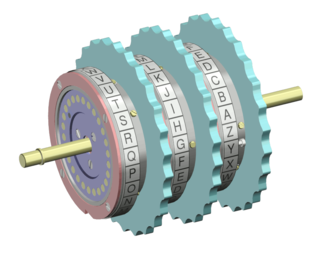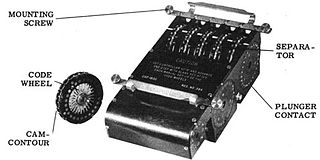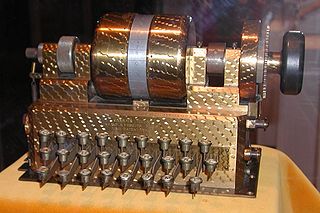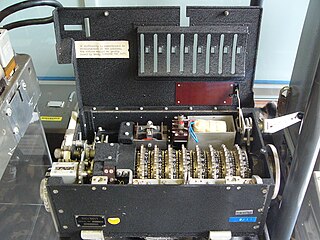 W
WIn cryptography, a rotor machine is an electro-mechanical stream cipher device used for encrypting and decrypting messages. Rotor machines were the cryptographic state-of-the-art for a prominent period of history; they were in widespread use in the 1920s–1970s. The most famous example is the German Enigma machine, the output of which was deciphered by the Allies during World War II, producing intelligence code-named Ultra.
 W
WThe Combined Cipher Machine (CCM) was a common cipher machine system for securing Allied communications during World War II and, for a few years after, by NATO. The British Typex machine and the US ECM Mark II were both modified so that they were interoperable.
 W
WCreed & Company was a British telecommunications company founded by Frederick George Creed which was an important pioneer in the field of teleprinter machines. It was merged into the International Telephone and Telegraph Corporation (ITT) in 1928.
 W
WThe Enigma machine is a cipher device developed and used in the early- to mid-20th century to protect commercial, diplomatic, and military communication. It was employed extensively by Nazi Germany during World War II, in all branches of the German military. The Germans believed, erroneously, that use of the Enigma machine enabled them to communicate securely and thus enjoy a huge advantage in World War II. The Enigma machine was considered to be so secure that even the most top-secret messages were enciphered on its electrical circuits.
 W
WIn cryptography, Fialka (M-125) is the name of a Cold War-era Soviet cipher machine. A rotor machine, the device uses 10 rotors, each with 30 contacts along with mechanical pins to control stepping. It also makes use of a punched card mechanism. Fialka means "violet" in Russian. Information regarding the machine was quite scarce until c. 2005 because the device had been kept secret.
 W
WThe Hebern Rotor Machine was an electro-mechanical encryption machine built by combining the mechanical parts of a standard typewriter with the electrical parts of an electric typewriter, connecting the two through a scrambler. It is the first example of a class of machines known as rotor machines that would become the primary form of encryption during World War II and for some time after, and which included such famous examples as the German Enigma.
 W
WThe HX-63 was an advanced rotor machine designed by Crypto AG, who started the design in 1952. The machine had nine rotors, each with 41 contacts. There were 26 keyboard inputs and outputs, leaving 15 wires to "loop back" through the rotors via a different path. Moreover, each rotor wire could be selected from one of two paths. The movement of the rotors was irregular and controlled by switches. There were two plugboards with the machine; one to scramble the input, and one for the loop-back wires. The machine could be set up in around 10600 different configurations.
 W
WThe TSEC/KL-7 was an off-line non-reciprocal rotor encryption machine. The KL-7 had rotors to encrypt the text, most of which moved in a complex pattern, controlled by notched rings. The non-moving rotor was in fourth from the left of the stack. The KL-7 with 12 rotors also encrypted the message indicator and was code named ADONIS.
 W
WIn the history of cryptography, M-325, also known as SIGFOY, was an American rotor machine designed by William F. Friedman and built in 1944. Between 1944 and 1946, more than 1,100 machines were deployed within the United States Foreign Service. Its use was discontinued in 1946 because of faults in operation. Friedman applied for a patent on the M-325 on 11 August 1944; it wasand was granted on 17 March 1959.
 W
WThe OMI cryptograph was a rotor cipher machine produced and sold by Italian firm Ottico Meccanica Italiana (OMI) in Rome.
 W
WPortex was a British cipher machine. A rotor machine, the device used eight rotors each with a tyre ring and an insert. The machine was used mainly by the secret services from the late 1940s to the early 1950s.
 W
WA reflector, in cryptology, is a component of some rotor cipher machines, such as the Enigma machine, that sends electrical impulses that have reached it from the machine's rotors, back in reverse order through those rotors. The reflector simplified using the same machine setup for encryption and decryption, but it creates a weakness in the encryption: with a reflector the encrypted version of a given letter can never be that letter itself. That limitation aided World War II code breakers in cracking Enigma encryption. The comparable WW II U.S. cipher machine, SIGABA, did not include a reflector.
 W
WThe Schlüsselgerät 41, also known as the SG-41 or Hitler mill, was a rotor cipher machine, first produced in 1941 in Nazi Germany, that was designed as a potential successor for the Enigma machine. It saw limited use by the Abwehr towards the end of World War II.
 W
WIn the history of cryptography, the ECM Mark II was a cipher machine used by the United States for message encryption from World War II until the 1950s. The machine was also known as the SIGABA or Converter M-134 by the Army, or CSP-888/889 by the Navy, and a modified Navy version was termed the CSP-2900.
 W
WSIGCUM, also known as Converter M-228, was a rotor cipher machine used to encrypt teleprinter traffic by the United States Army. Hastily designed by William Friedman and Frank Rowlett, the system was put into service in January 1943 before any rigorous analysis of its security had taken place. SIGCUM was subsequently discovered to be insecure by Rowlett, and was immediately withdrawn from service. The machine was redesigned to improve its security, reintroduced into service by April 1943, and remained in use until the 1960s.
 W
WIn the history of cryptography, 91-shiki ōbun injiki or Angōki Taipu-A , codenamed Red by the United States, was a diplomatic cryptographic machine used by the Japanese Foreign Office before and during World War II. A relatively simple device, it was quickly broken by western cryptographers. The Red cipher was succeeded by the Type B "Purple" machine which used some of the same principles. Parallel usage of the two systems assisted in the breaking of the Purple system.
 W
WIn the history of cryptography, Typex machines were British cipher machines used from 1937. It was an adaptation of the commercial German Enigma with a number of enhancements that greatly increased its security. The cipher machine was used until the mid-1950s when other more modern military encryption systems came into use.